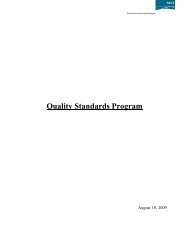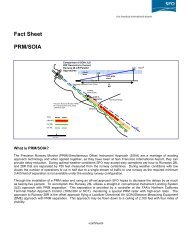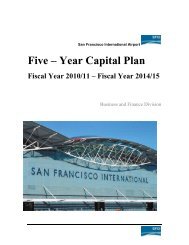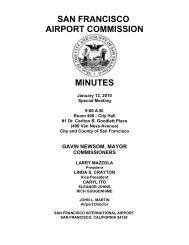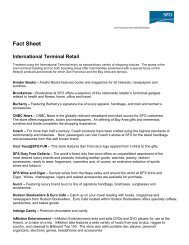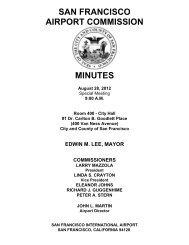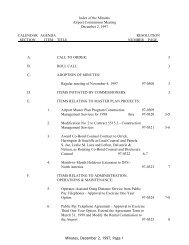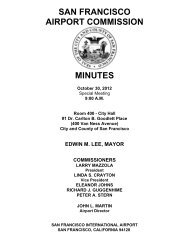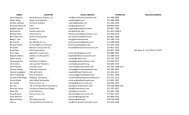Official Statement Airport Commission City and County of San ...
Official Statement Airport Commission City and County of San ...
Official Statement Airport Commission City and County of San ...
You also want an ePaper? Increase the reach of your titles
YUMPU automatically turns print PDFs into web optimized ePapers that Google loves.
<strong>Airport</strong> Security<br />
In the immediate aftermath <strong>of</strong> September 11, 2001, the FAA m<strong>and</strong>ated stringent new safety <strong>and</strong> security<br />
requirements, which have been implemented by the <strong>Commission</strong> <strong>and</strong> the airlines serving the <strong>Airport</strong>. In addition,<br />
Congress passed the Aviation <strong>and</strong> Transportation Security Act (the “Aviation Act”), which imposed additional<br />
safety <strong>and</strong> security measures. Certain safety <strong>and</strong> security functions at the <strong>Airport</strong> were assumed by the TSA, which<br />
was established by the Aviation Act. Among other things, the Aviation Act required that (i) as <strong>of</strong> January 18, 2002,<br />
explosive detection screening be conducted for all checked baggage; (ii) all individuals, goods, property, vehicles<br />
<strong>and</strong> other equipment entering secured areas <strong>of</strong> airports be screened; (iii) security screeners be federal employees,<br />
United States citizens <strong>and</strong> satisfy other specified requirements; <strong>and</strong> (iv) that vehicles be parked at least 300 feet from<br />
airport terminals.<br />
The <strong>Commission</strong>, the TSA <strong>and</strong> the airlines satisfied all <strong>of</strong> these requirements. The <strong>Airport</strong> installed in the<br />
ITC <strong>and</strong> in Terminals 1 <strong>and</strong> 3, 45 TSA certified, three dimensional, GE CTX 9000 explosive detection baggage<br />
screening machines to provide for 100% in-line checked baggage screening, as m<strong>and</strong>ated by the Aviation Act. The<br />
cost <strong>of</strong> acquisition <strong>and</strong> installation <strong>of</strong> the 45 machines was paid for by the TSA <strong>and</strong> FAA. In spring 2007, four GE<br />
CTX 9000 explosive detection baggage screening machines that provided redundant screening capability were<br />
removed from the Terminal Complex <strong>and</strong> three <strong>of</strong> these machines were installed as part <strong>of</strong> a cargo screening pilot<br />
program. The pilot program was completed in April 2008 <strong>and</strong> these machines were returned to the TSA. The fourth<br />
explosive detection baggage screening machine was allocated by the TSA for installation within a new Southwest<br />
Airlines st<strong>and</strong>-alone baggage screening system being installed in Terminal 1. No machines will be installed in<br />
Terminal 2 until spring 2011 when Terminal 2 is expected to be reopened for passenger traffic. See also “–Current<br />
<strong>Airport</strong> Facilities–Terminals–Other <strong>Airport</strong> Terminals.” The <strong>Airport</strong> may undertake a number <strong>of</strong> other required<br />
security related capital projects, a portion <strong>of</strong> the costs <strong>of</strong> which are expected to be funded by federal grants.<br />
The TSA operates nine separate security checkpoints containing 39 security lanes with employees <strong>of</strong> a<br />
private security firm, Covenant Aviation Security. The <strong>Airport</strong> is one <strong>of</strong> six airports in the nation in which the TSA<br />
operates security through their private partnership program. The employees <strong>of</strong> the private security firm undergo the<br />
same training <strong>and</strong> are under the same TSA management as federal-employed security operating at other United<br />
States airports. This private partnership program at the <strong>Airport</strong> has been in operation since 2002. TSA management<br />
utilizes staffing models <strong>and</strong> closed circuit images to monitor dem<strong>and</strong> checkpoints to quickly accommodate increases<br />
in passenger flow.<br />
The <strong>Airport</strong> is one <strong>of</strong> 19 domestic airports in the nation where the whole-body electromagnetic imaging<br />
screening machines are being used by the TSA, although, under certain circumstances, passengers may still opt to be<br />
screened through the current metal detector system. The costs <strong>of</strong> acquisition <strong>and</strong> installation <strong>of</strong> the whole-body<br />
imaging machines at the <strong>Airport</strong> was paid for by the TSA.<br />
On August 24, 2009, the Global Entry initiative, a U.S. Customs <strong>and</strong> Border Protection (CBP) pilot<br />
program that streamlines the arrival screening process at airports for trusted travelers through biometric<br />
identification, was extended to the <strong>Airport</strong> <strong>and</strong> 12 other airports. Global Entry enrollment centers <strong>and</strong> kiosks at the<br />
<strong>Airport</strong> allow pre-approved members an alternative to regular passport processing lines. At the kiosk, Global Entry<br />
members insert their passport or lawful permanent resident card into a document reader, provide digital fingerprints<br />
for comparison with fingerprints on file, answer customs declaration questions on the kiosk’s touch-screen, <strong>and</strong> then<br />
present a transaction receipt to CBP <strong>of</strong>ficers before leaving the inspection area.<br />
Airline Service<br />
General<br />
For Fiscal Year 2009-10 the <strong>Airport</strong> is served by 46 passenger <strong>and</strong> six cargo only airlines. Domestic<br />
passenger air carriers provide scheduled non-stop service to 70 destinations <strong>and</strong> scheduled one-stop service to an<br />
additional 26 destinations within the United States. Twenty-seven passenger airlines provide nonstop scheduled<br />
passenger service to 29 international airport destinations <strong>and</strong> one-stop service to an additional 13 international<br />
destinations.<br />
42



